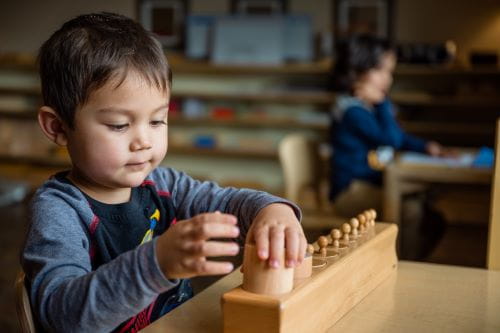The Montessori sensorial materials are a central component of the Early Childhood (EC) classroom, and are designed to help the child develop and refine their sense of sight, hearing, smell, touch, and taste. The materials for visual discrimination are varied—some focus on color, some on shape, and others on dimension. Those in the latter category include the Pink Tower, the Brown Stair, and the Red Rods. The Knobbed Cylinders, also known as the Solid Cylinders and Solid Insets, are the first materials presented to the child in this sequence, the ones that set in motion thinking about changes in dimension. As a sensorial material, the Knobbed Cylinders engage both the child’s sense of vision and touch.
Physical Properties of the Knobbed Cylinders
The material consists of four sets of ten wooden cylinders. Each set includes a block of wood with a hole for each cylinder. The cylinders are topped with a small knob, which facilitates the removal and replacement of the cylinders within their corresponding holes. Descriptions of the material vary slightly between sources (material makers and training programs), with the most commonly used descriptors of the differences and sequence as follows:
- Block 1: Cylinders increase in height and diameter
- Block 2: Cylinders increase in diameter as height remains constant
- Block 3: Cylinders increase in diameter as they decrease in height
- Block 4: Cylinders increase in height, diameter remains constant
Considerations Regarding Block 3
Interesting to note is that Montessori’s original description of the material (1914) only includes three of the four blocks described above, as addressed in her own handbook (p 29):
The opinions expressed in Montessori Life are those of the authors and do not necessarily represent the position of AMS.


